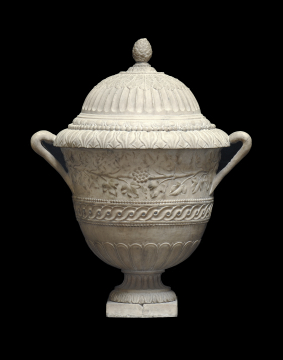Explore Collections


You are here:
CollectionsOnline
/
Roman funerary (cinerary) vase with a frieze of ivy leaves and berries.
Browse
Roman funerary (cinerary) vase with a frieze of ivy leaves and berries.
Pentelic marble
Height: 54cm, maximum
Height (excluding lid): 36cm
Height (pedestal, excluding modern square base): 6cm
Height (frieze): 10cm
Circumference (lid): 82cm
Width (base): 13.5cm, maximum
Height (excluding lid): 36cm
Height (pedestal, excluding modern square base): 6cm
Height (frieze): 10cm
Circumference (lid): 82cm
Width (base): 13.5cm, maximum
Museum number: M930
On display: Dome Area
All spaces are in No. 13 Lincoln's Inn Fields unless identified as in No. 12, Soane's first house.
For tours https://www.soane.org/your-visit
Curatorial note
The entire surface of the lid and bowl of this vase, above and below the frieze, is enriched with carving in the Piranesi manner: acanthus leaves, inverted fluting, a waterleaf lip, a guilloche moulding and piped convex fluting at the bottom of the bowl.
The most famous cinerary vase with foliate enrichment of this type is a 1st century example in the Vatican1. L. Curtius2 regards a number of these large marble kraters and cinerary vases as examples of Hellenestic, early Imperial or so-called Neo-Attic decorative motives. He is careful to separate the antique from the restored parts of the urns considered and to avoid discussion of vases such as this Soane example, the antiquity of which is open to more than passing suspicions!
1 P. Gusman, L'Art décoratif de la fin de la république au IV siécle, 2 vols, Paris, 1910, I, pl. 49; see also II, pl. 87.
2 Mitteilungen des deutschen archäologischen Instituts, Römische Abteilung 49, 1934, pp. 268-294.
The most famous cinerary vase with foliate enrichment of this type is a 1st century example in the Vatican1. L. Curtius2 regards a number of these large marble kraters and cinerary vases as examples of Hellenestic, early Imperial or so-called Neo-Attic decorative motives. He is careful to separate the antique from the restored parts of the urns considered and to avoid discussion of vases such as this Soane example, the antiquity of which is open to more than passing suspicions!
1 P. Gusman, L'Art décoratif de la fin de la république au IV siécle, 2 vols, Paris, 1910, I, pl. 49; see also II, pl. 87.
2 Mitteilungen des deutschen archäologischen Instituts, Römische Abteilung 49, 1934, pp. 268-294.
Purchased from Lord Mendip's Sale, 18 May1802, Lot. 51, £10.10.0.
Literature
Description of Sir John Soane's Museum, 1930, p.84, fig. 50 (upper left).
Soane collections online is being continually updated. If you wish to find out more or if you have any further information about this object please contact us: worksofart@soane.org.uk


